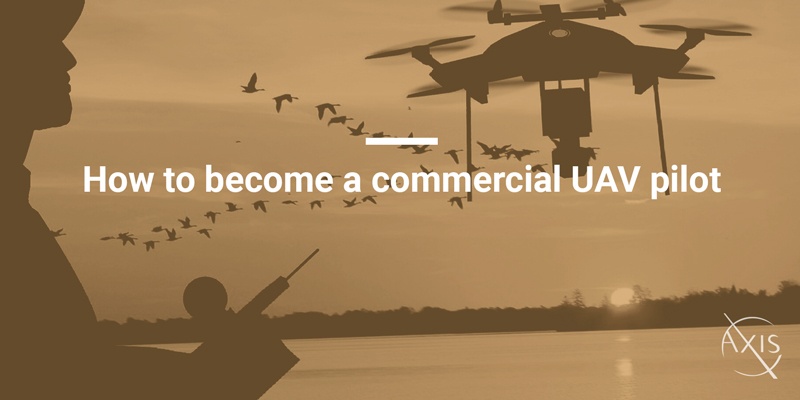So you want to turn your drone hobby into a business. Great! Here’s what you need to know to get started.
Commercial operation is defined as “any payment, consideration, gratuity or benefit, directly or indirectly charged, demanded, received or collected by any person for the use of an aircraft.” In other words, using your drone to make money.
When you decide to go from a purely recreational operator to a a commercial UAV pilot, it is important to understand what you need to be successful – and success begins with compliance. Transport Canada has published some material to answer the numerous questions you may have about exemptions, compliance, and commercial operations.
Ground School
When looking to establish yourself as commercial UAV pilot, one of the best investments that you can make is to enroll in an unmanned aerial vehicle ground school. The pilot ground school should cover Air Law, Navigation, Meteorology, General Aeronautics Knowledge (theory of flight, engines, airframes and systems, flight operations and human factors), UAS/UAV Operations, and Radiotelephony, as well as the most recent regulations that apply.
Ground school can give you an edge in a competitive market. It is very easy to find a ground school – a simple internet search will provide many options. But not all schools are on Transport Canada’s list of compliant and competent ground schools/providers.
It might seem that selecting your aircraft first would make the most sense, but until you’ve attended a ground school and figured out what direction to take your business, you may want to hold off. Ground school will match your aspirations and ideas with your skills and the regulatory realities to help you discover which aircraft is best for you.
The Right UAV
When choosing an aircraft, your selection should be based on logistical, pragmatic, personal and budgetary research. The options may seem limitless, and can be overwhelming. To a certain point – as it is with many purchases – the quality and versatility of an aircraft increases as the price increases. Answering these four questions will help guide your selection process.
1. What business niche in the commercial UAV market are you most interested in?
2. Which aircraft fits your skill level?
3. Which quality aircraft is within your budget?
4. Will the environment affect your work?
Standard Special Flight Operations Certificate
The process for applying for an initial SFOC application can be time consuming. Since, in most regions, there is not a standard form available to simply fill out and return, Transport Canada has provided an extensive outline. We’ve also found a few sample SFOC applications to give you an idea of what a completed one looks like.
Here is some of the information needed when writing your SFOC application:
• The name and contact information of the applicant
• The name and address of the person designated by the applicant to have operational control over the UAV system
• The method by which the operator may be contacted directly during operation
• The type and purpose of the operation
• The dates, alternate dates, and times of the proposed operation
• A complete description, including all pertinent flight data on the aircraft to be flown
• The security plan for the area(s) of operation and the area(s) to be overflown to ensure no hazard is created to persons or property on the surface
• The emergency contingency plan to deal with any disaster resulting from the operation
• The name of the person designated to be responsible for supervision of the operation area during the operation, if different from the operator
• A detailed plan describing how the operation will be carried out, which must include a clear, legible presentation of the area to be used during the operation
SFOC Non-Compliance
Transport Canada takes compliance with SFOC requirements very seriously. In the event that an operator conducts business without an SFOC, an individual may be fined $5,000. For corporations, the fines can climb to $25,000.
Commercial UAV Insurance
Many hopeful UAV operators assume that their personal or commercial insurance policy will extend to cover the use of their UAV. In reality, most policies have an exclusion relating to aviation within the wording. This is why a specific UAV insurance policy is needed.
Third-party UAV insurance can cover:
• Damage to and loss of the drone
• Damage to ground station equipment
• Damage to the payload (camera, sensors, etc.)
• Spare parts
• Third-party damages (property damage, bodily injury, and medical expenses)
• Malicious damage
• System hacking
• Personal injury
Within Transport Canada’s Advisory Circular it states that commercial pilots shall have no less than $100,000 in liability coverage pertaining to the operation of the UAV system. However, $100,000 doesn’t go a long way when it comes to legal expenses.
Operators can also purchase hull insurance to cover the loss of their equipment in the event of an incident. Typically, hull insurance starts to make since financially on aircraft over $5000. Our suggestion is that operators consider the areas they’ll be operating in, in addition to the equipment they’ll be flying. If you’ll often be flying the in vicinity of the public, expensive property including equipment and machines, you’ll likely want to increase your liability coverage beyond the minimum.
Apply for a drone insurance policy online through Drone Insurance Depot.


